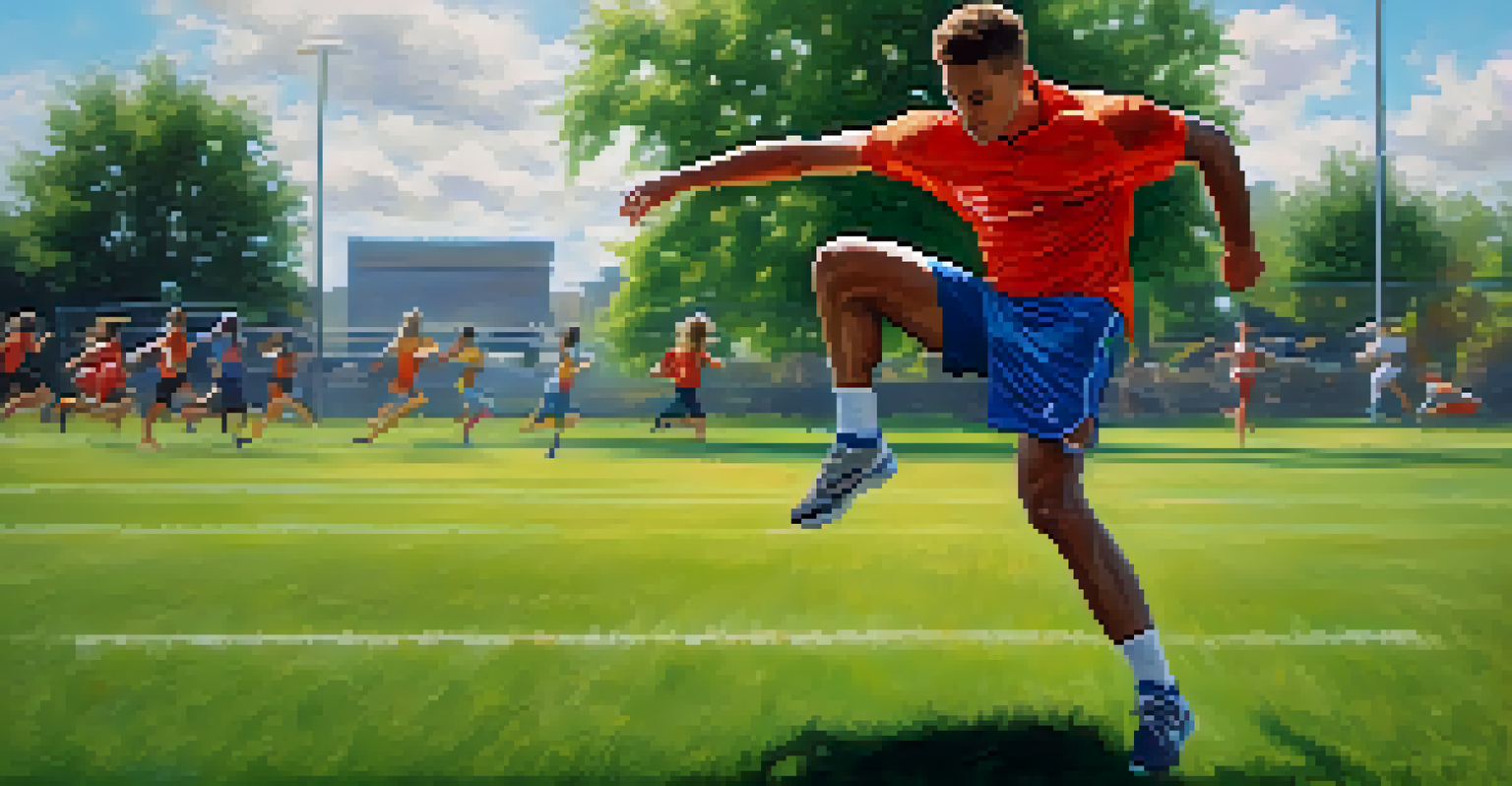Examining Dance as a Form of Injury Prevention in Sports

Understanding the Link Between Dance and Sports Injury Prevention
Dance and sports may seem worlds apart, but both require agility, balance, and strength. By examining how dance improves these physical attributes, we can see its potential as a preventive measure against injuries. The movements in dance enhance muscle memory, allowing athletes to perform with greater control and precision.
Dance is the hidden language of the soul.
Injuries often occur due to improper movement patterns or lack of flexibility. Dance incorporates dynamic stretching and fluid movements, which can significantly increase an athlete's range of motion. This flexibility can help prevent strains and sprains, which are common in various sports.
Moreover, dance promotes body awareness, teaching athletes to listen to their bodies and recognize their limits. This heightened awareness can lead to better decision-making during physical activities, ultimately reducing the risk of injury.
The Role of Flexibility in Dance and Injury Prevention
Flexibility is a key component of both dance and athletic performance. Dancers regularly engage in stretching routines that enhance their flexibility, which is crucial for preventing injuries like muscle strains. When athletes incorporate similar flexibility training, they can significantly reduce their injury risk.

For instance, ballet dancers often perform splits and high kicks, which require extraordinary flexibility. Athletes who adopt these stretching techniques can improve their own flexibility, allowing for more efficient movements in their respective sports. This not only enhances performance but also fortifies the body against injuries.
Dance Enhances Flexibility and Control
Incorporating dance techniques into training significantly improves flexibility, which helps athletes reduce their risk of injuries.
Research supports the idea that increased flexibility can lead to a lower incidence of injuries. By integrating dance-based flexibility routines into their training, athletes can create a more resilient physical foundation.
Balance and Coordination: Dance's Secret Weapons
Balance and coordination are essential skills in both dance and sports. Dancers train extensively to maintain their balance while executing complex movements, which translates well to athletic performance. Enhanced balance helps athletes maintain control during dynamic activities, reducing the likelihood of falls and injuries.
The body says what words cannot.
For example, a soccer player who practices dance techniques may find they can better navigate the field, avoiding collisions and awkward landings. This improved coordination not only boosts performance but also minimizes the chances of injury during high-paced games.
Incorporating dance into training routines can provide athletes with new ways to develop these skills. As they learn to shift their weight and control their movements, athletes can build a more robust physical toolkit to tackle their sports.
Incorporating Dance into Athletic Training Programs
Integrating dance into athletic training programs can be a game-changer for injury prevention. Coaches and trainers can develop hybrid workouts that blend traditional strength training with dance-inspired movements. This approach not only keeps workouts fresh but also targets multiple muscle groups effectively.
For example, a basketball player might benefit from incorporating hip-hop dance moves into their agility drills. This can enhance footwork, speed, and overall athleticism while simultaneously making training more enjoyable. A positive training experience fosters motivation and commitment to injury prevention.
Improved Balance Reduces Injury Risk
Dance training develops balance and coordination, allowing athletes to maintain control during dynamic movements and avoid falls.
Moreover, dance can serve as a low-impact cross-training option, allowing athletes to maintain their fitness while giving their bodies a break from the repetitive motions of their sport. This variety can help mitigate overuse injuries, which are common in many athletic disciplines.
The Mental Benefits of Dance in Sports Injury Prevention
Beyond physical benefits, dance also contributes to mental wellness, which plays a crucial role in injury prevention. Engaging in dance can reduce stress and anxiety, allowing athletes to focus better during training and competition. A clear mind is essential for making quick decisions that can prevent injuries.
Additionally, dance fosters creativity and self-expression, which can help athletes stay motivated and connected to their sport. When athletes feel connected and engaged, they are more likely to practice safe techniques and listen to their bodies, further reducing injury risks.
For instance, a gymnast who incorporates dance into their routine may find themselves more in tune with their movements, allowing them to adjust and adapt in real-time, preventing potential injuries during performances.
Real-Life Examples of Dance in Athletic Training
Many professional athletes have embraced dance-based training to enhance their performance and reduce injury risk. For instance, NFL players often participate in dance classes to improve their footwork and agility. This unconventional training method has shown promising results in both performance and injury prevention.
Similarly, figure skaters regularly incorporate dance into their routines to enhance their artistry and technical skills. The blending of dance and sport not only elevates their performance but also equips them with better body control and balance, reducing the likelihood of falls.
Mental Benefits Boost Athletic Performance
Engaging in dance can improve mental wellness, helping athletes focus better and make safer decisions during their sport.
These real-life examples highlight how effective dance can be when integrated into athletic training. As more athletes discover the benefits, we may see a shift in training methodologies across sports.
Conclusion: Embracing Dance for a Safer Athletic Future
In conclusion, examining dance as a form of injury prevention in sports reveals numerous benefits that can enhance athletic performance and well-being. From improved flexibility and balance to mental resilience, the advantages are clear. Embracing dance in athletic training can lead to a safer, more effective approach to sports.
Athletes and coaches should consider incorporating dance techniques into their training regimens for a holistic approach to injury prevention. By doing so, they can cultivate a more adaptable and resilient body, ready to face the challenges of their sport.

Ultimately, the integration of dance into sports training fosters a deeper understanding of movement and body mechanics. This not only helps in preventing injuries but also enriches the athletic experience, making it more fulfilling and enjoyable.